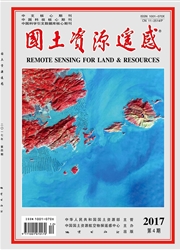

 中文摘要:
中文摘要:
为了提高从高分辨率遥感图像(high-resolution remote sensing image,HRI)中提取道路信息的自动化程度和准确性,发展了一种HRI道路分割算法,主要包括光谱合并、边界合并和基于形状特征的道路区域提取等3个步骤。其中,前2个步骤是基于区域生长的图像分割算法。光谱合并综合考虑了区域的均值、方差等统计特征量,以提高分割精度;边界合并采用了基于矢量梯度的边界计算方法,以准确提取多光谱HRI中的边界强度;结合全局最优合并算法实现光谱和边界合并,以得到最优化的分割结果。在道路区域被完整分割出来的基础上,利用形状特征提取道路,采用圆形度特征区分道路和非道路。利用2景Orb View3多光谱图像进行道路提取实验的结果表明,该方法的道路提取结果总精度和Kappa系数分别在97%和0.8以上,明显优于SVM监督分类方法。
 英文摘要:
英文摘要:
In order to enhance the automation and accuracy of road information extraction from the high - resolution remote sensing image ( HRI), this paper proposes a HRI road segmentation algorithm, which includes 3 stages, i.e. , spectral mergence, edge mergence, and road region extraction based on shape property. The first two stages are actually the image segmentation method based on region growing. Spectral statistic variables, such as average and variance, are considered in the spectral merging criteria to raise segmentation accuracy. A vector gradient method is used to accurately derive edge strength that is critical for edge merging criterion. Spectral and edge mergences are all implemented as global best merge algorithm, so the segmentation result is optimized. On the premise of the complete segmentation of the roads, shape properties can be effectively used to extract roads from HRI. Circularity is adopted to separate roads from non -road regions. Two scenes of OrbView3 multispectral images are used to carry out road extraction experiment. The experimental result shows that the overall accuracy and Kappa coefficient of the method proposed in this paper are above 97% supervised classification. and O. 8, respectively, obviously superior to the result of SVM
 同期刊论文项目
同期刊论文项目
 同项目期刊论文
同项目期刊论文
 期刊信息
期刊信息
